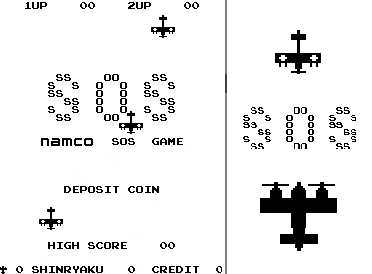Shooter Gallery #6: The Best Defense Is a Dead Alien
Nevertheless, some developers found a way. In some cases, rather than simply asking the player to destroy enemies, designers had them use their firepower in a defensive role. Crossing shooters like Lunar Rescue (1979) provided a natural setting for such mechanics, but more direct Space Invaders descendants were also introducing defensive elements. In the games that follow, the player’s shots and movements serve two purposes: to destroy the enemy, but also to assist allies.
SOS (Namco, 1979)
There's something to be said for distracting the player from single-minded destruction, but it's only a mild distraction in this case. One-dimensional gameplay sinks this shooter, but others were bolder.
Cosmic Guerilla (Universal, 1979)
Cosmic Guerilla was one of the first original shooters after Space Invaders. If you want to stay alive as long as possible, you must protect your reserve lives, which are laid out in the center of the screen. Surrounding your reserves are little sprites that look like soldiers (the manual refers to them as "blocks") that "cosmic guerillas" can grab and drag off the screen. If you shoot the guerillas while they have a block in their possession, it will return to its original position.
The need to rescue the blocks from the aliens doesn't change the player's interactions with the guerillas a great deal. They’re all attacking your blocks, so they’re all equal-value targets. Occasionally, one of the guerillas starts assaulting your enclave at high speed, at which point you must take them out quickly or risk losing one of your lives. Even then, however, all of the other guerillas freeze and you're left in a one-on-one matchup with the offending guerilla. It's interesting to see the player's goals shift slightly, but there is much more room for innovation.
Stratovox (Sun Electronics, 1980)
With Stratovox, we finally see a defensive scenario with broad strategic implications. Initially, the game plays out like any other fixed shooter, with the player just trying to shoot without being shot.
Learning to exploit the enemy dive patterns takes some time, but is within the reach of an intermediate-level player. Once you can complete a wave or two, you'll start having to worry more about protecting your allies. If aliens kidnap all 10 of the people on the right side of the screen, you will lose the game. What's interesting about these kidnappings is that they happen much more rapidly when carried out by a single enemy than by multiple enemies.
This sometimes rewards the player for destroying fewer of the enemies during their dive pattern. In the left panel above, I take out two of the three aliens during their dive, but the third gets away with an ally. If I instead wait until the ally is captured by all three aliens, as in the right panel, I can easily pick off two of them during their return trip. The same number of aliens are destroyed at the end, but in the second case have I saved an ally.
In the second wave and beyond, the game starts sending multiple groups of aliens at the same time, so the strategy somewhat, but there remains a strong disincentive to leaving isolated enemies. Despite the increased emphasis on defense in Stratovox, however, I still found myself running out of lives more often than I ran out of allies. Can we take this concept even further?
King and Balloon (Namco, 1980)
King and Balloon is the culmination of the "defensive" fixed shooter, replacing the player's life counter with the king's. Your objective is to protect the king -- player deaths only matter insomuch as they provide a brief period of time in which the enemy can carry away the king.
The first few times I played King and Balloon, I approached it like most other fixed shooters, trying to maneuver myself between gaps in the enemy attack and take out as many balloons as possible. The balloons all appear to follow the same basic pattern, with only slight variations from one to the next.
I largely avoided targeting the diving balloons, since their jumpy motions made them difficult to hit. This is not unique to King and Balloon -- in many fixed shooters, you can destroy waves with less risk by focusing on the armada. There was at least one respect, however, in which this was not like other shooters.
It was a mistake to focus on my own survival. Once I learned to treat my gunners as secondary -- that is, stay near the king even if it meant taking a bullet -- I could usually take down any balloons that happened to lift him. I even found that it sometimes helped to intentionally sacrifice myself in order to ensure a timely respawn.
New mechanics are only really worthwhile if they force the player to rethink their interaction with the game, and King and Balloon is a great example of this for defensive mechanics. Unsurprisingly, its lead designer, Shigeru Yokoyama, would have other successes, most notably Galaga the following year.
Big Picture
Shoot 'em ups were evolving rapidly by 1980 and defensive game mechanics were just one of the things that developers were experimenting with. The most famous example during the golden age is probably in the scrolling shooter, Defender (1981), but these early experiments with fixed shooters demonstrate how they can be incorporated effectively into even simpler designs.









Comments
Post a Comment